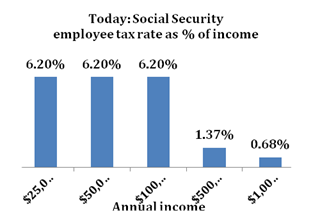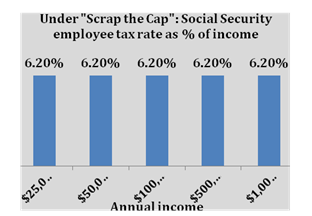NATIONAL
The simple Social Security fix that no one wants to talk about
SEATTLE —Today’s news coverage of the “grim, dismal” outlook for the nation’s most important and popular social insurance system belies the truth about the relative health of the Social Security system, and it completely ignores the simple fix proposed to ensure its solvency indefinitely.
The 2012 Social Security Trustees’ Report shows the is on sound financial footing for at least another generation. With $2.7 trillion in its trust fund, Social Security can pay full benefits through 2033. After that year, the program can still pay 75% of benefits, even with no action by Congress. And because of how Social Security calculates benefits, that “75%” of benefits will still be, on average, higher in inflation-adjusted dollars than full benefits are today.
 But proponents of the so-called “Scrap the Cap” plan say Social Security can pay 100% of benefits after 2033, and even modestly expand benefits today, if Congress makes one simple change: eliminate Social Security’s cap on taxable income (now set at $110,100) so high-income earners pay the same tax rate as middle class workers.
But proponents of the so-called “Scrap the Cap” plan say Social Security can pay 100% of benefits after 2033, and even modestly expand benefits today, if Congress makes one simple change: eliminate Social Security’s cap on taxable income (now set at $110,100) so high-income earners pay the same tax rate as middle class workers.
The additional funding could boost benefits for low-income earners, add credits for individuals (often women) who take time from work to raise their family, and restore benefits for college students that were cut in the 1980’s.
 “These improvements immediately boost the American economy, build economic security for women, and safeguard educational opportunities for young people who have suffered the loss of a parent,” said Marilyn Watkins, policy director for the Economic Opportunity Institute, a Seattle-based non-profit public policy center.
“These improvements immediately boost the American economy, build economic security for women, and safeguard educational opportunities for young people who have suffered the loss of a parent,” said Marilyn Watkins, policy director for the Economic Opportunity Institute, a Seattle-based non-profit public policy center.
Social Security benefits are more critical to American economic security than ever. According to estimates, nearly one-half of Americans will be unable to maintain their standard of living in old age. About 1 in 4 households in Washington state — more than 1 million Washingtonians, including 73,000 children — received old age, survivor, or disability benefits from Social Security in December 2010.
For more information, visit the Economic Opportunity Institute website at www.eoionline.org.
Now, once more, with feeling…





